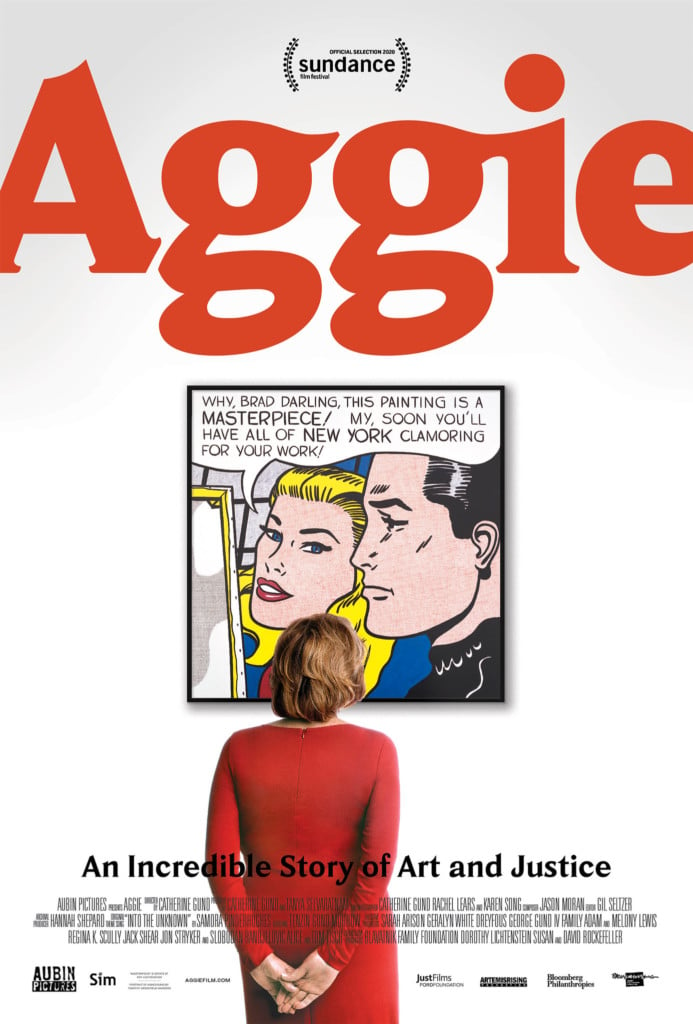
If you’ve been to the Museum of Modern Art in New York at any point over the last fifty years, chances are, you’ve seen a work donated by Agnes Gund—after all, she’s given more than 900 works to the institution.
Known fondly as Aggie, Gund is a quiet force who prefers to avoid the spotlight. So why did she allow her daughter to make her the star of a new documentary? According to director Catherine Gund, Aggie’s answer was simple: “Because you asked.”
Titled simply Aggie, the film debuted at this year’s Sundance Film Festival, and has been described as a love letter between the generations. (For her part, and perhaps in jest, Aggie said she “hopes not too many people see it.”) On Tuesday evening, the film was shown at MoMA, followed by a celebratory reception.
As Catherine Gund addressed the packed audience, she described the New York City premiere as a homecoming of sorts: “I thought it was daunting and exciting to have the world premiere at Sundance, but that was nothing compared to this!” The theater was studded with MoMA board members, as well as many artists whose work features in the documentary, including Teresita Fernandez, Lyle Ashton Harris, Glenn Ligon, Julie Mehretu, Clifford Ross, and Phong Bui.
Jack Shear, Aggie Gund, and Catherine Gund at the premiere of Aggie (2019) at MoMA.
A stalwart of the philanthropic scene in New York, Gund has spent the last fifty years putting her money where her passion is, helping to enhance museums and arts education. Among most people in the art world, she needs no introduction. In 2017 she sold Roy Lichtenstein’s painting Masterpiece (a personal favorite of Gund’s, it had been hanging in her own home for decades) for a staggering $165 million to kick off the Art for Justice Fund.
Upon its creation, the Fund announced its intention to disperse all of Lichtenstein funds within five years, meting out chunks of money to individual artists and organizations. It’s core mission is “disrupting mass incarceration by funding artists and advocates working together to reform our criminal justice system.” Together with the Ford Foundation’s president Darren Walker (and with a little help thanks to celebrity endorsements from Oprah, Ava Duvernay, and Brian Stevenson) the fund is making major inroads to redress the systematic abuses of mass incarceration.
Aggie tells a deeper story that goes well beyond such headline-grabbing milestones. The documentary, for instance, explores Gund’s founding of the Studio in a School program in the 1970s, with the goal of ensuring that arts education remained in New York City schools. Testimonials from former students of the program are an affecting addition to the film, giving a face to those who have benefited directly from Gund’s largess.
Poster image of Aggie by Catherine Gund, an official selection of the Documentary Premieres program at the 2020 Sundance Film Festival. Courtesy of Sundance Institute.
The film is soundtracked with an original score composed by jazz musician and artist Jason Moran, and features curators, artists, and patrons speaking one-on-one with Agnes in her home. We’re privy to a slew of interesting tidbits. Catherine Opie describes Gund as “breaking the mold of the traditional housewife” when she moved to New York City to raise her children alone, after leaving an unhappy marriage. In a conversation with Glenn Ligon, Aggie bemoans that MoMA—where she is now President emerita, having previously overseen the board from 1991 until 2002—only acquired Faith Ringgold’s arresting mural American People Series No. 20: Die in 2016, almost 50 years after it was painted in 1967.
Ultimately, what shines through brightest in the film is not the scope of Gund’s generosity, but her true and persistent love of art. She recalls visiting the Cleveland Museum as a child and first understanding “what I could do in life was to figure out art.” After becoming a mother, she went back to school to earn her masters in curating at Harvard’s Fogg Museum. At 81, she still regularly visits artists’ studios to see their work in progress. As for the fund, Catherine said they hoped to extend its original timeline, carrying on charitable giving for a sixth year.
At one point in the film, Ligon quipps that the “most powerful tool we have right now in the art world is shame.” That shame might be directed at museum board members with questionable business ties, or toward wealthy collectors who aren’t willing to give back for the greater good. At least in Aggie, we find a shining example of generosity, one that other would-be patrons would do well to follow.
“Aggie” will be showing at Film Forum beginning in September.